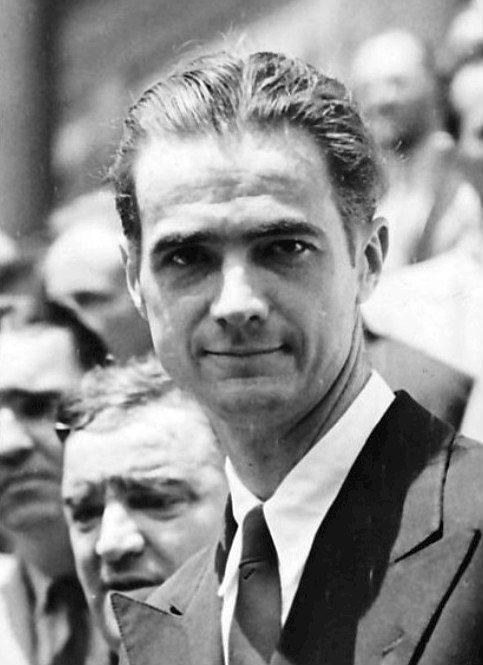
FROM WIKIPEDIA COMMONS
Round-the-world flight
On July 14, 1938, Hughes set another record by completing a flight around the world in just 91 hours (three days, 19 hours, 17 minutes), beating the previous record set in 1933 by Wiley Post in a single-engine Lockheed Vega by almost four days. Hughes returned home ahead of photographs of his flight. Taking off from New York City, Hughes continued to Paris, Moscow, Omsk, Yakutsk, Fairbanks, and Minneapolis, then returning to New York City. For this flight he flew a Lockheed 14 Super Electra (NX18973, a twin-engine transport with a four-man crew) fitted with the latest radio and navigational equipment. Harry Connor was the co-pilot, Thomas Thurlow the navigator, Richard Stoddart the engineer, and Ed Lund the mechanic. Hughes wanted the flight to be a triumph of American aviation technology, illustrating that safe, long-distance air travel was possible. Albert Lodwick of Mystic, Iowa, provided organizational skills as the flight operations manager. While Hughes had previously been relatively obscure despite his wealth, being better known for dating Katharine Hepburn, New York City now gave him a ticker-tape parade in the Canyon of Heroes. Hughes and his crew were awarded the 1938 Collier Trophy for flying around the world in record time. He was awarded the Harmon Trophy in 1936 and 1938 for the record-breaking global circumnavigation.
In 1938 the William P. Hobby Airport in Houston, Texas—known at the time as Houston Municipal Airport—was renamed after Hughes, but the name was changed back due to public outrage over naming the airport after a living person. Hughes also had a role in the design and financing of both the Boeing 307 Stratoliner and Lockheed L-049 Constellation.
Other aviator awards include: the Bibesco Cup of the Fédération Aéronautique Internationale in 1938, the Octave Chanute Award in 1940, and a special Congressional Gold Medal in 1939 “in recognition of the achievements of Howard Hughes in advancing the science of aviation and thus bringing great credit to his country throughout the world”.
President Harry S. Truman sent the Congressional medal to Hughes after the F-11 crash. After his around-the-world flight, Hughes had declined to go to the White House to collect it.
HERE IS TODAY’S ALMANAC
1500s
1550s
1830s
- BORN 1830: CAMILLE PISSARRO (PAINTER)
- BORN 1834: JAN NERUDA (POET)
- BORN 1834: JAMES MCNEILL WHISTLER (PAINTER)
- BORN 1839: ADOLPHUS BUSCH (BREWERY EXECUTIVE)
1850s
1870s
1890s
1900s
- 1900: HIS MASTER’S VOICE TRADEMARK (SHOWING THE DOG NIPPER AND A GRAMOPHONE) WAS REGISTERED IN THE UNITED STATES
- BORN 1905: MILDRED WIRT BENSON (ORIGINAL AUTHOR, UNDER THE PEN NAME CAROLYN KEENE, OF THE NANCY DREW MYSTERY BOOKS)
1910s
- 1912: GEORGE HODGSON BECAME CANADA’S FIRST DOUBLE OLYMPIC GOLD MEDALIST FOR SWIMMING
- BORN 1914: JOE SHUSTER (CARTOONIST, CO-CREATOR OF SUPERMAN COMIC)
1920s
- BORN 1920: DAVID BRINKLEY (REPORTER & COMMENTATOR)
- BORN 1921: EUNICE KENNEDY SHRIVER
- BORN 1921: JAKE LAMOTTA (BOXER)
- BORN 1926: FRED GWYNNE (ACTOR)
1930s
1940s
- DIED 1941: JELLY ROLL MORTON (JAZZ MUSICIAN)
- BORN 1943: ARTHUR ASHE (TENNIS PLAYER)
- BORN 1945: VIRGINIA WADE (TENNIS PLAYER)
- BORN 1947: ARLO GUTHRIE (FOLK SINGER)
1960s
- BORN 1960: ROGER CRAIG (FOOTBALL PLAYER)
- 1962: TELSTAR, AN EXPERIMENTAL COMMUNICATIONS SATELLITE PRIVATELY OWNED AND DEVELOPED BY AT&T, WAS LAUNCHED FROM CAPE CANAVERAL, FL
1970s
- 1973: THE BAHAMAS GAINED FULL INDEPENDENCE WITHIN THE BRITISH COMMONWEALTH
- DIED 1979: ARTHUR FIEDLER (ORCHESTRA CONDUCTOR)
1980s
- BORN 1980: JESSICA SIMPSON (SINGER)
- BORN 1980: ADAM PETTY (NASCAR DRIVER)
- DIED 1989: MEL BLANC (VOICE OF BUGS BUNNY AND OTHER CHARACTERS)
1990s
2000s
2010s
COURTESY www.almanac.com
